

The Tormentil Mining Bee Andrena tarsata is an UK Biodiversity Action Plan (UKBAP) or Section 41 Conservation Priority Species. The Tormentil Nomad Bee Nomada roberjeotiana is Red Data Book species (RDB3). This bee is a cleptoparasite which requires nests of The Tormentil Mining Bee. Between 2009-2020 I have been surveying both bees within Cornwall. Tormentil Mining Bee on Cornwall Wildlife Trusts Bartinney Nature Reserve (2020)
The Cornish population of The Tormentil Nomad is nationally significant. In 2014/6 I found 6 new sites for the nomad, well away from exsisting sites. This bee has only been recently recorded on a few sites outside Cornwall, in Northern England, Scotland and Wales. Further details of both bees are at Comprehensive survey of West Penwith area for Rare bees
The Tormentil Mining Bee is a ground nesting bee which forages exclusively on Tormentil Potentilla erecta to provision its offspring. In Europe it has been observed utilising other related plants. The Tormentil Nomad is a clepto-parasite which usurps the nest and provisions stored by the Tormentil Mining Bee. The nomad bee relies on a strong host population of the Tormentil Mining Bee (which is why it is such a rare bee).
The Tormentil Mining Bee occurs on a range of sites including acid grassland, heathland, woodland rides and brownfield sites with high abundance and density of Tormentil flowers probably being the most critical factor.
The Tormentil Mining Bee nests in small aggregations in warm sheltered areas. It utilises sheltered banks and/or bare ground features for nesting, either in level ground or vertical, in a range of substrates from compacted clay to loose sandy peaty soil.
I found two nest sites of both the Tormentil Mining Bee and The Tormentil Nomad Bee in 2015. Both sites were on the south east facing side of a low (1-3 ft) hedgebank, occurring within the steeper slopes of the bank or on almost flat patches of bare ground where the bank had collapsed, where there was either a thin cover of grass or bare ground, although on these banks a range of aspects were used for nesting. One Tormentil Mining Bee and The Tormentil Nomad Bee were found on a north facing bare ground feature and it seems likely the species does nest in situations other than south facing banks.
In Scotland Little & Jarman found 40 - 50 nest burrows in an area of bare ground 2m sq. which suggests quite small areas of suitable nest sites may be needed compared to the area of flowering Tormentil.
The Cornish populations of these bees occur on Bodmin moor and West Penwith. Although the Lizard does need further survey. The Tormentil bee has been recorded on the Mid-Cornwall moors, although I revisited the site and think it is likely to be extinct.
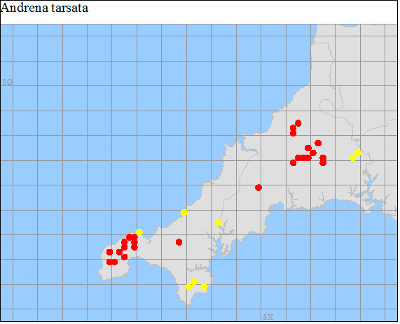
The Tormentil Mining Bee Records in Cornwall. Post 2000 records in red. Pre 2000 records in yellow.
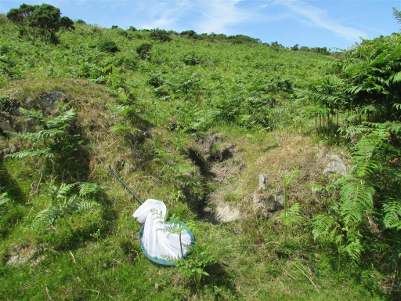
Tormentil Nomad Bee Nest Site: West Cornwall
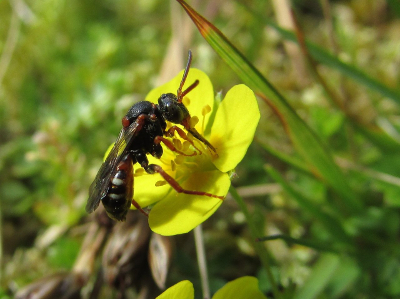
Tormentil Nomad Bee Female
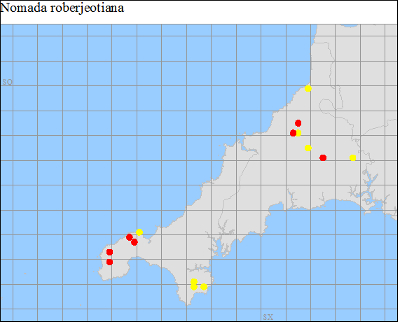
The Tormentil Nomad Bee records in Cornwall. Post 2000 records in red. Pre 2000 records in yellow.
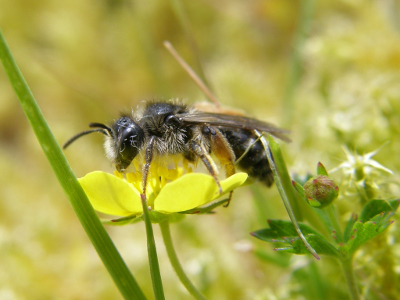
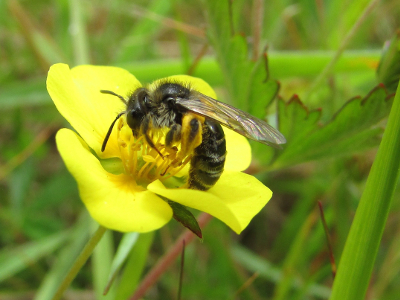
Tormentil Mining Bee Andrena Tarsata Females
Tormentil is one of the most common flowering plants on Bodmin moor proper. Its ability to withstand very hard grazing means in some areas it is the only flowering plant!
The Tormentil Mining Bee historically had a fairly wide distribution in Cornwall on a range of habitats such as coastal heaths, brownfield sites, woodland and upland grassland.
Typical sites have more 'lush' Tormentil with larger numbers of flowers in comparison with moorland in general. Some sites with colonies have a more sheltered microclimate than the open moor (Davidstow woods), but others seems fairly exposed (Collliford hatchery).
(Paddy Saunders Kernow ecology)
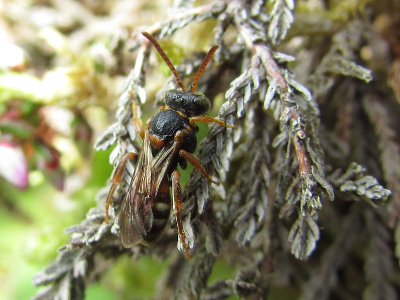
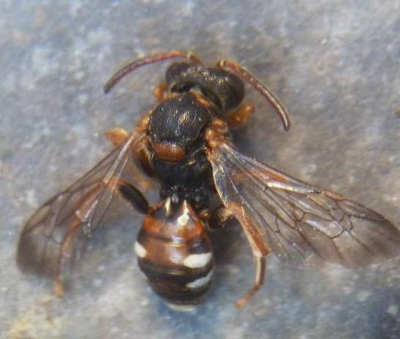
Female Tormentil Nomad Bee
For further info see:
Buglife Tormentil Bee Management: Info Sheet